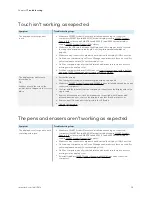
Chapter 5
Troubleshooting
smarttech.com/kb/171414
54
Symptom
Troubleshooting steps
The image on the screen is distorted.
OR
There are lines, snow or, other visual
noise on the screen.
OR
The image if flickering or flashing.
OR
The image is dim.
l
Tap the
Home
button
below the screen or press the
Home
button
on the
remote control to open the Home screen. If it appears correctly, the issue is with the
video input.
l
Switch to a different input and then back to the first input.
l
Make sure any connected computers are on and not in an energy savings mode.
l
Restart the display and any connected computers.
Turning off, turning on, and resetting the display on page
46.
l
Set any connected computers’ resolution and refresh rate to values that the display
supports.
l
Replace the video cables that connect any computers to the display to determine if
the issue is with the cables.
(For SMART Board 6000S (V3) and
6000S (C) models)
There is no image when using the
USB Type-C receptacle with a
computer
l
Make sure that the computer supports Display Port Alternate Mode video via USB
Type-C. Look for the Display Port logo beside the USB Type-C receptacle on the
computer. If it’s not there, the computer may not support Display Port Alternate
Mode video via USB
Type-C.
l
Make sure the cable used with the USB Type-C receptacle supports Super Speed
(5Gbps) USB. Look for the Super Speed USB logo on the cable. If the cable doesn’t
have the Super Speed USB logo, it may not have the internal wiring necessary to
carry Display Port Alternate Mode video data.
There are bright spots on the screen.
l
Tap the
Home
button
below the screen or press the
Home
button
on the
remote control to open the Home screen. If it appears correctly, the issue is with the
video input.
l
Take a photograph of the screen and send it to SMART support. If SMART support
determines that the issue is with the screen and the display is under warranty, you
may be eligible for a replacement.
Colors don’t appear correctly.
l
Be aware that if two or more displays are mounted side-by-side, there could be
minor differences in colors across the displays. This issue is not unique to SMART
products.
l
If the screen is completely lacking one color on the screen or the color problems
occur on the Home screen, see
Contacting your reseller for additional support on
l
If you’re using a VGA video input, use a different cable or connect a different source
to see if the issue is with the cable or input source.
l
Adjust the display’s color settings, or reset them to the factory defaults.
Appendix A Adjusting settings on page
60.
The image is cut off or shifted to the
left or right.
l
Adjust any connected computers’ video settings, particularly zoom, crop, and
underscan.
See the computer’s operating system documentation.
l
If you’re using a VGA video input and any connected computers’ desktops are
entirely black, change them to dark gray or a different color.
l
If any connected computers’ desktops are extended across multiple screens,
duplicate the desktops across the screens or set the display as the only screen.
The image doesn’t fill the entire
screen.
l
Adjust any connected computers’ video settings, particularly overscan.
See the computer’s operating system documentation.
l
Make sure the connected computer’s video connector is configured to output a
supported video signal. See No video display output from a laptop.
A persistent image appears on the
display.















































